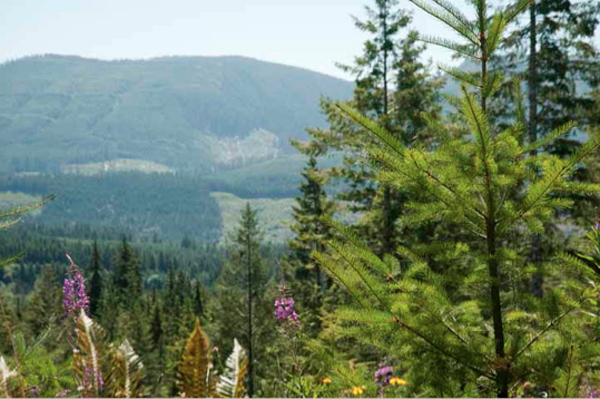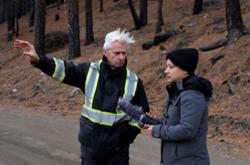[Editor's note: British Columbia's economy is growing. Much of that growth rests on expanded resource industries. Yet our laws designed to protect the unparalleled beauty and richness of the B.C. environment have been weakened, both federally and provincially, over the past decade. Over the next few weeks, this Tyee special series, in cooperation with the Environmental Law Centre at the University of Victoria, will reveal what B.C.'s leading experts in environmental law say most needs to be fixed, and their specific suggestions for change. To read all their recommendations, download the free electronic publication "Maintaining Natural British Columbia for Our Children: Selected Law Reform Proposals." Today, we look at the need for land use planning.]
Change #2: Fixing land use planning
By Jessica Clogg
Beginning 20 years ago, community members, stakeholders and government representatives sat down around planning tables across the province and worked out strategic land use plans that cover most of British Columbia. Addressing large regional or sub-regional areas, each plan determined lands to be protected, along with resource management zones and objectives for unprotected areas. As well, a Biodiversity Strategy provided for landscape-level planning for biodiversity values.
Twenty years on, it is possible to look at the outcomes from these planning initiatives. How well are they serving us in managing the cumulative environmental impacts of resource activities, combined with climate change? Will they sustain our environment, communities and economy in the 21st century?
Scientific review suggests we have reason to be concerned. A recent, comprehensive assessment of the province's natural environment concluded: "The cumulative impacts of human activities in British Columbia are increasing and are resulting in the loss of ecosystem resilience." And: "Ecosystem degradation from forestry, oil and gas development, and transportation and utility corridors has seriously impacted British Columbia's biodiversity."
In addition: "Climate change is already significantly impacting healthy ecosystems in British Columbia, and will likely cause more dire consequences for fragmented or degraded ecosystems."
Given the dedicated efforts of so many British Columbians to strategic land use planning in most areas of the province, how can this be?
First, significant parts of the province have still not undergone land use planning -- including the Lower Mainland, Sunshine Coast and Merritt areas. Second, the provincial government has cut its support for land use planning, and instituted an operations-focused agency to, "get the development permits out."
But there are also fundamental problems with laws and policies that govern planning, and with the legal tools used to implement plans. In a recently released report, ForestEthics Solutions for the first time mapped environmental designations -- the on-the-ground legacy of B.C.'s strategic planning efforts -- for the whole province. In a companion report, West Coast Environmental Law analyzed the resource management direction these legal tools provide.
Land use laws show gaping holes
We have discovered an array of legal and policy barriers that undermine the ability to achieve resilience in our ecological systems and for human communities. For example:
- For close to a decade it was provincial policy to design land use planning processes as "multi-stakeholder" negotiations without proper government-to-government engagement with First Nations. This meant both lost opportunities to benefit from Indigenous knowledge about the land and water, and uncertainty about the constitutionality of planning outcomes like the establishment of new protected areas;
- Provincial policy limited how much land could be set aside from development. These limits were political and subjective, and in many cases limited the extent to which planning outcomes reflected best available science and Indigenous knowledge;
- All but the most recent strategic land use plans failed to consider climate change in identifying management objectives, either in terms of its impacts, or with respect to forest carbon management (vast stores of carbon present in forests are released into the atmosphere as greenhouse gases after logging);
- Legal requirements flowing from strategic land use plans do not apply to all resource industries. In particular, mining is excluded. And there is no legal linkage between land use plans and environmental assessment. For those resource sectors to which land use plans do apply, B.C. laws contain a number of exemptions and loopholes that compromise their effectiveness;
- Even when land use plan objectives do apply, there is generally no legal mechanism for coordinating decision making among resource agencies or between provincial and First Nations governments to ensure that the cumulative impacts of past, present and foreseeable future activities do not exceed limits established in land use plans, or otherwise compromise important values; and
- Monitoring and updating of land use plans has rarely, if ever, occurred.
A handful of government-to-government agreements between First Nations and the Crown have now pioneered more comprehensive and science/Indigenous knowledge-based land use planning; for example, in the territories of the Coastal First Nations, the Gitanyow and the Taku River Tlingit. These innovative agreements are being implemented together with new approaches to collaborative decision-making and economic benefit sharing, and there is much to learn from them. However, many of the same barriers continue to present challenges to their effective implementation.
For example, some areas of the province are dealing with simultaneous proposals for mining, forestry, hydroelectric, oil and gas development, as well as related roads, power lines and other infrastructure. While each form of development may be subject to regulatory approvals and, in some cases, project-specific environmental assessment, there is currently no legal mechanism that requires a coordinated assessment of cumulative impacts beyond the footprint of an individual project. Perhaps more importantly, no law requires the outcomes be integrated into decision-making.
Updating our strategic land use plans can contribute to this goal, while potentially opening up new economic opportunities for rural and First Nations communities. Our research suggests a number of elements could benefit such a process:
- Reinstate a land-use planning mandate within the provincial government. This could be a distinct, neutral agency with dedicated planning expertise.
- Carry out land use planning for areas of the province where it has not taken place, in a manner consistent with the other recommendations here.
- Build on existing plans. In recent legislative committee hearings around the province, British Columbians resoundingly affirmed that areas currently reserved from logging to protect water, wildlife and other values should not be re-opened. If anything, they said, we should be doing more to sustain our natural life-support systems in the face of climate change.
- Begin from the best available scientific and Indigenous knowledge of how to sustain ecological and societal values, taking climate change into account. Support land use decision-making with detailed mapping -- to identify areas with high conservation values for biodiversity, and those with high potential to store carbon in natural ecosystems over the long term.
- Ensure future land use decision-making is inclusive, participatory and just, while recognizing the Constitutionally protected role of First Nations in their territories. New institutions, independent from existing ministries or the Environmental Assessment Office will likely be required.
- Fully integrate the outcomes from broad-scale, proactive regional cumulative effects assessment and land use planning into our land management system. To be effective, land use designations and management objectives should apply to all resource industries and government decisions about land and water.
- Implement and sustain monitoring programs and practice adaptive management. We need to know if management objectives are being met and are effective at achieving our goals. Legal frameworks need to include triggers for action if they are not.
The situation is urgent. Human activities and climate change are already beginning to put our natural life support systems and the communities that depend on them under stress. We must act now to give ecosystems, species and ultimately ourselves a fighting chance.
The good news is that improved management and protection of our natural environment will favour new economic opportunities linked to conservation, ecosystem restoration and climate adaptation -- key elements of a "clean economy" anticipated to generate employment gains and revenues of $2.3 trillion in our region by 2020.
For more information, see:
Provincial Land Use Planning: Which Way from Here? Forest Practices Board. (2008)
Taking Nature's Pulse: The Status of Biodiversity in British Columbia. Biodiversity BC. (2008)
A New Climate for Conservation: Nature, Carbon and Climate Change in British Columbia. West Coast Environmental Law. (2010)
The West Coast Clean Economy Study, Opportunities for Investment & Accelerated Job Creation. GLOBE Advisors and the Center for Climate Strategies. (2012) ![]()
Read more: BC Politics, Environment

















Tyee Commenting Guidelines
Comments that violate guidelines risk being deleted, and violations may result in a temporary or permanent user ban. Maintain the spirit of good conversation to stay in the discussion.
*Please note The Tyee is not a forum for spreading misinformation about COVID-19, denying its existence or minimizing its risk to public health.
Do:
Do not: